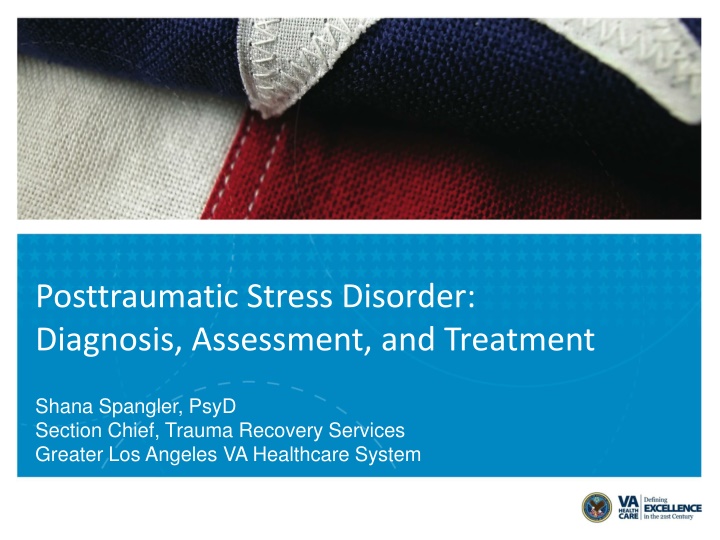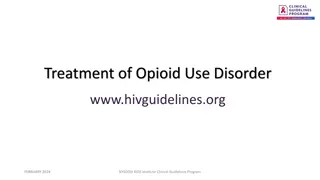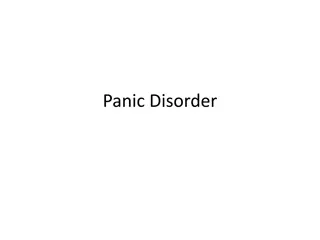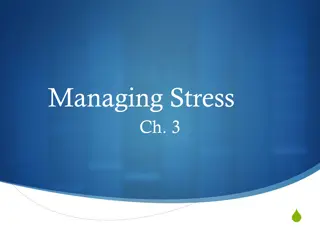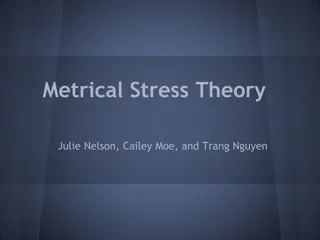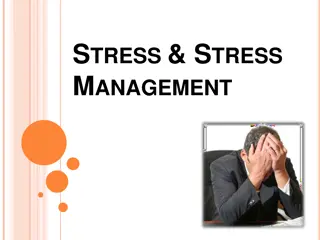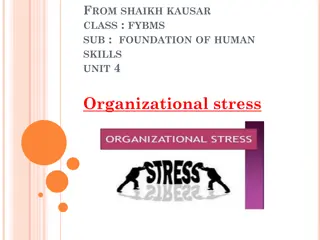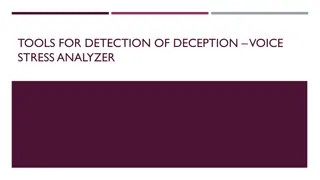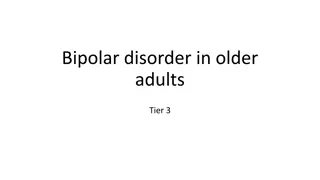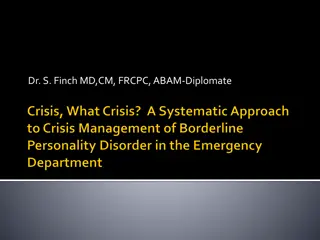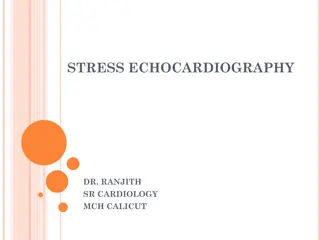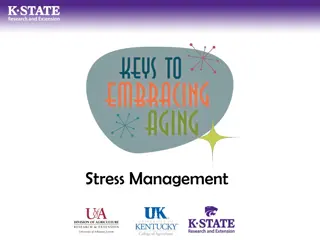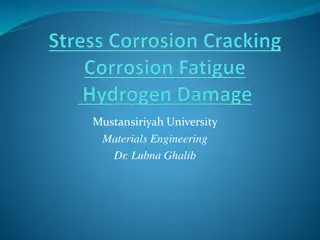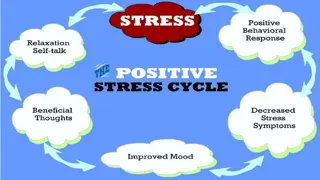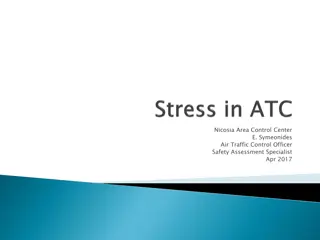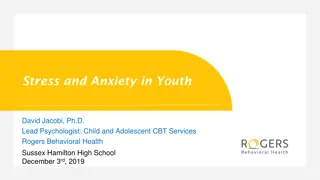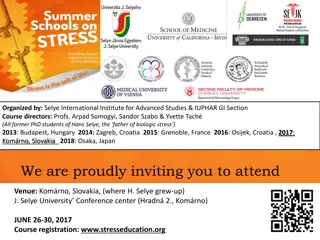Posttraumatic Stress Disorder: Diagnosis, Assessment, and Treatment
Posttraumatic Stress Disorder (PTSD) is a serious mental health condition characterized by various symptoms following exposure to a traumatic event. This presentation covers the DSM-5 diagnostic criteria, assessment methods, and treatment options for PTSD. It explores the different criteria, such as traumatic stressors, intrusion symptoms, avoidance, negative alterations in cognition and mood, alterations in arousal and reactivity, as well as the time period and severity considerations. Examples of traumatic events that can lead to PTSD are discussed, along with the importance of proper diagnosis and treatment.
Download Presentation

Please find below an Image/Link to download the presentation.
The content on the website is provided AS IS for your information and personal use only. It may not be sold, licensed, or shared on other websites without obtaining consent from the author.If you encounter any issues during the download, it is possible that the publisher has removed the file from their server.
You are allowed to download the files provided on this website for personal or commercial use, subject to the condition that they are used lawfully. All files are the property of their respective owners.
The content on the website is provided AS IS for your information and personal use only. It may not be sold, licensed, or shared on other websites without obtaining consent from the author.
E N D
Presentation Transcript
Posttraumatic Stress Disorder: Diagnosis, Assessment, and Treatment Shana Spangler, PsyD Section Chief, Trauma Recovery Services Greater Los Angeles VA Healthcare System
Outline of Presentation DSM-5 Diagnostic Criteria Assessment LEC, PCL-5, CAPS Overview of treatments Avoidance Other considerations Disclaimer: Today we will be discussing sensitive material, please feel free to step out at any time if you need a break.
Objectives Learn to identify and talk about symptoms of PTSD and common reactions to trauma Develop an increased ability to assess for PTSD using questionnaires and clinical interviews Understand two of the empirically supported treatments for PTSD
What is PTSD? Diagnosis Diagnostic and Statistical Manual-5 (DSM-5) Trauma and Stress or Related Disorders Criterion A: Traumatic stressor Criterion B: Intrusion symptoms (Re-experiencing) Criterion C: Avoidance Criterion D: Negative alterations in cognition and mood Criterion E: Alterations in arousal and reactivity Criterion F: Time period Criterion G: Severity Criterion H: Not substance-related or GMC (APA, 2013)
What is PTSD? Criterion A The person was exposed to: death, threatened death, actual or threatened serious injury, or actual or threatened sexual violence as follows (one required): Direct exposure Witnessing, in person Indirectly, by learning that a close relative or close friend was exposed to trauma. If the event involved actual or threatened death, it must have been violent or accidental Repeated or extreme indirect exposure to aversive details of the events, usually in the course of professional duties
What is PTSD? Criterion A Examples Combat Physical or sexual assault (e.g., military sexual trauma, MST) Sexual trauma in the military does not occur only during training or peacetime and in fact, the stress of war may be associated with increases in rates of sexual harassment and assault Can be childhood or adult-related Domestic violence Serious accident (e.g., auto accident) Natural disaster First responders, EMTs, Trauma therapists (NCPTSD, 2016b)
What is PTSD? Criterion B Re-experiencing Recurrent, involuntary & intrusive memories Distressing dreams, nightmares Flashbacks: feeling that the event is actually happening again Psychological distress and/or physiological reactivity to cues Auditory (loud noises, helicopters, sirens, crying), visual (seeing people), smell (diesel fuel) https://www.youtube.com/watch?v=bgpRw92d1MA&fea ture=youtu.be Sweating, rapid heartbeat and breathing when thinking about the trauma (anniversary dates) (NCPTSD, 2016b)
What is PTSD? Criterion C Avoidance Avoid thoughts, feelings, conversations associated with the trauma (internal) Substance use/abuse, avoiding the news Avoid activities, places, people that arouse recollections (external) Avoiding going to sleep (e.g., if abused as a child in your bed), avoiding driving (e.g., after crash) , avoiding concerts because too open/crowded (e.g. makes you feel hypervigilant) (NCPTSD, 2016b)
What is PTSD? Criterion D Negative alterations in cognitions and mood Inability to recall key features of the traumatic event Not due to head injury, alcohol or drugs Persistent (and often distorted) negative beliefs and expectations about oneself or the world I am bad. The world is completely dangerous. Persistently negative trauma-related emotions Fear, horror, anger, guilt or shame Diminished interest in activities previously enjoyed Feeling alienated from others (e.g., detachment) Sadness, hopeless, outside looking in Persistent inability to experience positive emotions
What is PTSD? Criterion E Alterations in arousal and reactivity Sleep difficulty Anger problems, irritability, aggressive behavior Conflict with others Self-destructive or reckless behavior Aggressive driving Concentration difficulty Staring out during class, frequent absences, difficulty meeting deadlines, poor performance, problems staying on task Always on-guard (hypervigilance) Feeling nervous, helpless, edgy, difficulty with crowds, constantly scanning/assessing for threat Exaggerated startle response (NCPTSD, 2016b)
What is PTSD? Criterion F, G, & H Duration of symptoms is more than 1 month Significant distress and impairment Concerns arise when the disruptive reactions continue or get worse over time and interfere with family, work, school, or social life Commonly occurs with delayed expression. To get this specifier full diagnosis is not met until at least 6 months after the trauma(s), although onset of symptoms may occur immediately Disturbance not due to substance or GMC
How common is PTSD? 60% of men, 50% of women will experience a traumatic stressor in their lifetime 8% of men, 20% of women develop PTSD after a trauma Most people who are exposed to trauma will have some symptoms of PTSD following the event; Adjustment is normal! PTSD has a waxing and waning course, which may increase with major life events (e.g., +/- stress, change of life role) (NCPTSD, 2016a)
Assessment: Measures Life Events Checklist PTSD Checklist Use at intake to assist in assessing symptoms and weekly to track treatment progress PCL-S, M, C PCL-5 Range 0-80, 20 items, each item 0-4 score Provisional dx with symptom cluster (2 moderately or higher) Cluster B (items 1-5), cluster C (items 6-7), cluster D (items 8-14), and cluster E (items 15-20) Cutoff of 33 (until further psychometric work available) Look for B: 1, C: 1, D: 2; E: 2; F: >1 month (Weathers et al., 2015)
Assessment: Measures Clinician-Administered PTSD Scale for DSM-5 (CAPS-5) Gold standard in PTSD assessment, takes 45-60 minutes 30-item structured interview administered by clinicians and clinical researchers 20 items target onset and duration of symptoms, others target distress, impact, validity, severity Good to give depression screener as well (e.g., BDI, PHQ-9) Training: https://www.ptsd.va.gov/professional/continuing_ed/caps5_c linician_training.asp
Assessment: Measures Sample CAPS Item: Onset, duration & frequency In the past month, have you had any unwanted memories of (EVENT) while you were awake, so not counting dreams? How does it happen that you start remembering (EVENT)? [If not clear:] (Are these unwanted memories, or are you thinking about [EVENT] on purpose?) How much do these memories bother you? Are you able to put them out of your mind and thing about something else? How often have you had these memories in the past month? # of times ______.
Assessment: Measures Sample CAPS item: Severity Rating: 0. Absent: The respondent denied the problem 1. Mild / subthreshold: The respondent described a problem that is consistent with the symptom criterion but isn't severe enough to be considered clinically significant. 2. Moderate / threshold: The respondent described a clinically significant problem. The problem would be a target for intervention. This rating requires a minimum frequency of 2 x month or some of the time (20-30%) PLUS a minimum intensity of Clearly Present. 3. Severe / markedly elevated: The respondent described a problem that is above threshold. The problem is difficult to manage and at times overwhelming, and would be a prominent target for intervention. This rating requires a minimum frequency of 2 x week or much of the time (50-60%) PLUS a minimum intensity of Pronounced. 4. Extreme / incapacitating: The respondent described a dramatic symptom, far above threshold. He problem is pervasive, unmanageable, and overwhelming, and would be a high-priority target for intervention.
Assessment: Clinical Interview Assess for co-occurring conditions, including depression, suicidality, substances Draw out conceptualization of PTSD using symptoms that they provide Be attuned to role of avoidance http://www.ptsd.va.gov/professional/a ssessment/overview/index.asp Re- Experiencing Avoidance Negative Cognitions & Mood Arousal
Treatments: Review List of empirically supported treatments includes: Cognitive Processing Therapy (CPT) Prolonged Exposure (PE) Eye Movement Desensitization Reprocessing (EMDR)
Treatments: APA Clinical Practice Guideline for the Treatment of PTSD in Adults (released 2/24/17) Table 1. Summary of Recommendations of the APA Guideline Development Panel for the Treatment of PTSD (released in 2017)
Treatments: VA/DOD Clinical Practice Guideline for the Management of Posttraumatic Stress Disorder and Acute Stress Disorder Released in 2017 Strong recommendation: [I]ndividual, manualized trauma-focused psychotherapy (see Recommendation 11) over other pharmacologic and non-pharmacologic interventions for the primary treatment of PTSD. Strong recommendation: For patients with PTSD, we recommend individual, manualized trauma-focused psychotherapies that have a primary component of exposure and/or cognitive restructuring to include Prolonged Exposure (PE), Cognitive Processing Therapy (CPT), Eye Movement Desensitization and Reprocessing (EMDR), specific cognitive behavioral therapies for PTSD, Brief Eclectic Psychotherapy (BEP), Narrative Exposure Therapy (NET), and written narrative exposure.
Treatments: Cognitive Processing Therapy (CPT) Predominantly social-cognitive theory Reconcile information about the trauma with prior schemas Theory that recovery from trauma is a natural process and some people get stuck due to: 1. Unprocessed natural emotions 2. Ways of thinking, especially that beliefs become extreme after trauma (*focus) assimilation vs. accommodation Treatment addresses stuck points through: Assessment of stuck points: Impact statement Identification of stuck points: written trauma statement (optional) Reviewing common stuck point areas of: Safety, Trust, Power/control, Esteem, Intimacy Using CBT approaches to challenge extreme thinking
Treatments: Cognitive Processing Therapy (CPT) General overview Session 1: Introduction and Education Session 7: Patterns of Problematic Thinking Session 2: The Meaning of the Event Session 8: Safety Issues Session 3: Identification of Thoughts and Feelings Session 9: Trust Issues Session 4: Remembering the Traumatic Event Session 10: Power/Control Issues Session 5: Identification of Stuck Points Session 11: Esteem Issues Session 6: Challenging Questions Session 12: Intimacy Issues and Meaning of the Event
Treatments: Cognitive Processing Therapy (CPT) Resick, P.A., Monson, C.M., & Chard, K.M. (2017). Cognitive Processing Therapy for PTSD: A comprehensive manual. New York: Guilford. Used to have trauma account; now it is up to the patient to decide if they want to do the trauma account.
Treatments: Prolonged Exposure (PE) Theory: two factors maintain PTSD Avoidance of internal and external reminders (primary) Inaccurate & unhelpful trauma-related beliefs & thoughts Avoidance prevents emotional processing of the trauma & modification of trauma-related beliefs Mechanisms of PE Promote emotional engagement with trauma memories (opposite of numbing) Habituation of anxiety Modify erroneous cognitions Discriminate between the event and now
Treatments: Prolonged Exposure (PE) Treatment Education (common reactions to trauma, rationale for treatment) Breathing retraining In vivo exposures (external) Imaginal exposures (internal) As treatment goes on, focus is on hot spots where the narrative is not fully processed Processing and organization of the trauma (digesting) is focus of treatment
Treatments: PE Handouts In vivo exposure homework recording form Situation that you practiced____________ Date & Time SUDS Post Date & Time SUDS Post Pre Peak Pre Peak 1. 2. 3. 4. 5. 6. 7. 8. Imaginal exposure homework recording form DATE & TIME SUDS Pre SUDS Post Peak SUDS
Treatments: Other EMDR Information processing therapy: focus on the traumatic event/s, current triggers. Uses dual stimulation with bilateral eye movements, tones, or taps while engaging in imaginal exposure CBT for PTSD DBT-PE for Complex Trauma Incorporates phase-based treatment, Stage 1= Stabilization, Stage 2= PE CBT-I and PE
Avoidance Efforts to avoid feelings (numbing), thoughts (don t think about it), behaviors (avoid people, places) Maintains symptoms of PTSD Patient avoidance: Not selecting or disclosing the index trauma Humor Focus on other issues/distraction Not completing homework Not coming in Holding back emotion (anger, sadness)
Avoidance Therapist avoidance The patient is too fragile right now. Not checking on homework Focusing on stressful daily events instead of homework Not asking for details
Avoidance Addressing avoidance Discuss it early (normalize) You may notice anxiety about coming in... Problem-solve What could get in the way of coming in? There s No Such Thing as a Dragon Motivational enhancement Keep doing the homework (don t collude with the avoidance) Consult!
Treatments: Video clip The War Within: Treating PTSD CBS 60 minutes
Additional Considerations: Primary Care Primary Care: Provide education about symptoms and presentation Ex. Sexual trauma can have a significant impact on feeling safe in the room, especially with providers who are the same gender as the perpetrator; increased avoidance/distress related to invasive exams Ex. Nightmares can indicate distress (e.g., increase related to a divorce with rumination about negative life event) rather than reflect a response to a traumatic event Discuss how PTSD can impact health Explore the use of a screener (PC-PTSD5) Positive screen does not indicate PTSD, but reflects that symptoms are present that may require further evaluation. Available online: https://www.ptsd.va.gov/professional/assessment/documents/pc-ptsd5-screen.pdf (Prins et al., 2015)
Additional Considerations: Psychosocial Stressors Other stressors: Homelessness Legal issues School, work, family stressors Medical illness Active substance use Insomnia
References American Psychiatric Association. (2013). Diagnostic and statistical manual of mental disorders (5th ed.). Washington, DC: Author. American Psychological Association. (2017). Clinical practice guideline for the treatment of Posttraumatic Stress Disorder (PTSD) in Adults. Retrieved from the APA website on October 10, 2018, https://www.apa.org/ptsd-guideline/ptsd.pdf Department of Veterans Affairs and Department of Defense. (2010). VA/DoD clinical practice guideline for the management of post-traumatic stress: Guideline summary. National Center for PTSD. (2016a). How common is PTSD. Retrieved from the National Center for PTSD Website on August 17, 2016, http://www.ptsd.va.gov/public/PTSD- overview/basics/how-common-is-ptsd.asp. National Center for PTSD. (2016b). What is PTSD?. Retrieved from the National Center for PTSD Website on August 17, 2016, http://www.ptsd.va.gov/public/PTSD- overview/basics/what-is-ptsd.asp.
References Prins, A., Bovin, M. J., Kimerling, R., Kaloupek, D. G, Marx, B. P., Pless Kaiser, A., & Schnurr, P. (2015). Primary Care PTSD Screen for DSM-5 (PC-PTSD-5) [Measurement instrument]. Retrieved from the National Center for PTSD Website on September 10, 2018, https://www.ptsd.va.gov/professional/assessment/screens/pc-ptsd.asp VA/DOD (2017). VA/DOD Clinical practice guideline for the management of posttraumatic stress disorder and acute stress disorder. Retrieved on October 10, 2018 from https://www.healthquality.va.gov/guidelines/MH/ptsd/VADoDPTSDCPGFinal0124 18.pdf Weathers, F.W., Litz, B.T., Keane, T.M., Palmieri, P.A., Marx, B.P., & Schnurr, P.P. (2013). The PTSD Checklist for DSM-5 (PCL-5). Scale available from the National Center for PTSD at www.ptsd.va.gov.
